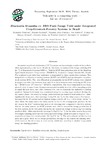Please use this identifier to cite or link to this item:
http://www.alice.cnptia.embrapa.br/alice/handle/doc/1061820| Title: | Brachiaria brizantha cv. BRS Piatã forage yield under integrated crop-livestock-forestry systems in Brazil. |
| Authors: | PEREIRA, M.  GLATZLE, S.   DOS SANTOS, V. A. C.   MORAIS, M. da G.   SANTOS, J. M. de F.   ALMEIDA, R. G. de   |
| Affiliation: | MRIANA PEREIRA, UFMS; SARAHGLATZLE, University of Hohenheim; VALÉRIA ANA CORVALÃ Dos SANTOS, UNESP; MARIA DAS GRAÇAS MORAIS, UFMS; JULIANA MARA DE FREITAS SANTOS, University of Hohenheim; ROBERTO GIOLO DE ALMEIDA, CNPGC. |
| Date Issued: | 2016 |
| Citation: | In: TROPENTAG 2016: INTERNATIONAL CONFERENCE ON RESEARCH ON FOOD SECURITY, NATURAL RESOURCE MANAGEMENT AND RURAL DEVELOPMENT, Vienna, 2016. Solidarity in a competing world - fair use of resources: book of abstracts. Göttingen: Cuvillier, 2016. |
| Description: | Integrated crop-livestock-forestry (ICLF) systems are increasingly considered for a diversified agricultural production in Brazil. In this study we analysed the forage yield [kg DM ha?1], of Brachiaria brizantha BRS cv. Piat?a for ICLF demonstration plots at the Brazilian Agricultural Research Corporation - EMBRAPA, located in Campo Grande-MS, Brazil. The analysed plots with four replicates corresponded to three production systems: Two integrated crop-livestock-forestry systems (ICLF1 and ICLF2) and an integrated crop-livestock system (ICL). The trees (Eucalyptus urograndis) in the ICLF systems were planted in single rows with 2m between tress and 14 or 22m between rows, resulting in 357 trees ha?1 (ICLF1) and 277 trees ha?1 (ICLF2), respectively. The crop component is soy-bean, planted every 4 years. Grass biomass was sampled monthly in a line of five sampling points at equal distance from each other between tree rows to represent the understory shading gradient. Animal feed intake was considered using the moving cages method. During the dry season (June - October) the forage yields between the different treatments didn?t differ significantly from each other (average 5.4 kg DM ha?1). In the rainy season (November - January) the ICLF system had the highest forage yield (ICLF 17.7 > ICL 6.6 kg DM ha?1). Most likely the main reason for these results is due to the management practice. In the dry season the ICLF systems had such a low stocking rate compared to the ICL system, that in the rainy season the ICLF systems were able to exceed the forage production of the ICL system. In the tree plots during the dry season the forage yields along the shading gradient didn?t differ significantly (average 5.3 kg DM ha?1). In the rainy season the points with higher shading (near the tree rows) had lower forage yields (9.9 and 11.8 kg DM ha?1, respectively) than the central points (16.1 kg DM ha?1). The microclimate within the tree plots has a great effect on the forage production. During the dry season the shading effect of the trees on the whole area is more evenly distributed resulting in similar forage yields along the shading gradient. |
| NAL Thesaurus: | Agroforestry Savannas Shade Tropical grasslands |
| Keywords: | Brazilian savannah |
| Type of Material: | Resumo em anais e proceedings |
| Access: | openAccess |
| Appears in Collections: | Resumo em anais de congresso (CNPGC)  |
Files in This Item:
| File | Description | Size | Format | |
|---|---|---|---|---|
| Brachiariabrizanthacv.BRSPiata.pdf | 717,13 kB | Adobe PDF |  View/Open |









